初中英语“一般现在时”
- 格式:docx
- 大小:15.08 KB
- 文档页数:1
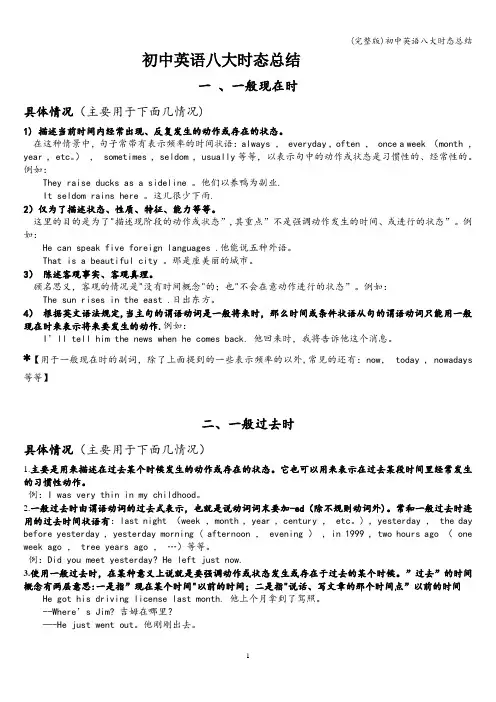
初中英语八大时态总结一、一般现在时具体情况(主要用于下面几情况)1) 描述当前时间内经常出现、反复发生的动作或存在的状态。
在这种情景中,句子常带有表示频率的时间状语:always , everyday , often , once a week (month ,year , etc。
), sometimes , seldom , usually等等,以表示句中的动作或状态是习惯性的、经常性的。
例如:They raise ducks as a sideline 。
他们以养鸭为副业.It seldom rains here 。
这儿很少下雨.2)仅为了描述状态、性质、特征、能力等等。
这里的目的是为了"描述现阶段的动作或状态”,其重点”不是强调动作发生的时间、或进行的状态”。
例如:He can speak five foreign languages .他能说五种外语。
That is a beautiful city 。
那是座美丽的城市。
3)陈述客观事实、客观真理。
顾名思义,客观的情况是"没有时间概念"的;也"不会在意动作进行的状态”。
例如:The sun rises in the east .日出东方。
4)根据英文语法规定,当主句的谓语动词是一般将来时,那么时间或条件状语从句的谓语动词只能用一般现在时来表示将来要发生的动作.例如:I’ll tell him the news when he comes back. 他回来时,我将告诉他这个消息。
*【用于一般现在时的副词,除了上面提到的一些表示频率的以外,常见的还有:now, today , nowadays 等等】二、一般过去时具体情况(主要用于下面几情况)1.主要是用来描述在过去某个时候发生的动作或存在的状态。
它也可以用来表示在过去某段时间里经常发生的习惯性动作。
例:I was very thin in my childhood。
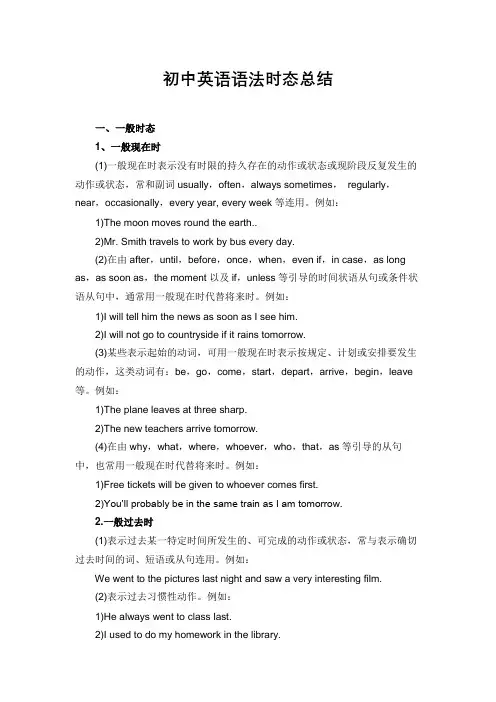
初中英语语法时态总结一、一般时态1、一般现在时(1)一般现在时表示没有时限的持久存在的动作或状态或现阶段反复发生的动作或状态,常和副词usually,often,always sometimes,regularly,near,occasionally,every year, every week等连用。
例如:1)The moon moves round the earth..2)Mr. Smith travels to work by bus every day.(2)在由after,until,before,once,when,even if,in case,as long as,as soon as,the moment以及if,unless等引导的时间状语从句或条件状语从句中,通常用一般现在时代替将来时。
例如:1)I will tell him the news as soon as I see him.2)I will not go to countryside if it rains tomorrow.(3)某些表示起始的动词,可用一般现在时表示按规定、计划或安排要发生的动作,这类动词有:be,go,come,start,depart,arrive,begin,leave 等。
例如:1)The plane leaves at three sharp.2)The new teachers arrive tomorrow.(4)在由why,what,where,whoever,who,that,as等引导的从句中,也常用一般现在时代替将来时。
例如:1)Free tickets will be given to whoever comes first.2)You’ll probably be in the same train as I am tomorrow.2.一般过去时(1)表示过去某一特定时间所发生的、可完成的动作或状态,常与表示确切过去时间的词、短语或从句连用。
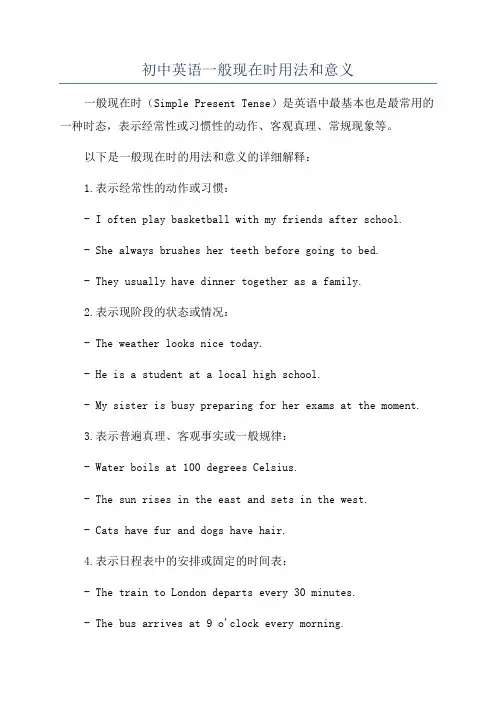
初中英语一般现在时用法和意义一般现在时(Simple Present Tense)是英语中最基本也是最常用的一种时态,表示经常性或习惯性的动作、客观真理、常规现象等。
以下是一般现在时的用法和意义的详细解释:1.表示经常性的动作或习惯:- I often play basketball with my friends after school.- She always brushes her teeth before going to bed.- They usually have dinner together as a family.2.表示现阶段的状态或情况:- The weather looks nice today.- He is a student at a local high school.- My sister is busy preparing for her exams at the moment.3.表示普遍真理、客观事实或一般规律:- Water boils at 100 degrees Celsius.- The sun rises in the east and sets in the west.- Cats have fur and dogs have hair.4.表示日程表中的安排或固定的时间表:- The train to London departs every 30 minutes.- The bus arrives at 9 o'clock every morning.- The English class takes place on Monday and Wednesday.5.表示评论、意见或个人观点:- I think he is a talented musician.- The movie is very interesting.- They believe in working hard to achieve success.6.表示感觉或外貌形态:- The cake smells delicious.- The flowers look beautiful in the garden.- The music sounds pleasant.7.口头表达指令、建议或禁令(一般情况下):- Close the door, please.- Don't run in the hallway.- Be quiet during the movie.8. 结构“there be”表示处存在物或人:- There is a park near my house.- There are many books on the shelf.- There is a girl waiting for you at the entrance.需要注意的是,一般现在时通常用于第三人称单数时,动词的变化需要在动词原形的基础上加上“s”或“es”后缀:- I play ▶︎ He plays- They go ▶︎ She goes- We have ▶︎ It has总结起来,一般现在时是英语中最基础的一种时态,用于表示经常性或习惯性的动作、客观真理、常规现象等。
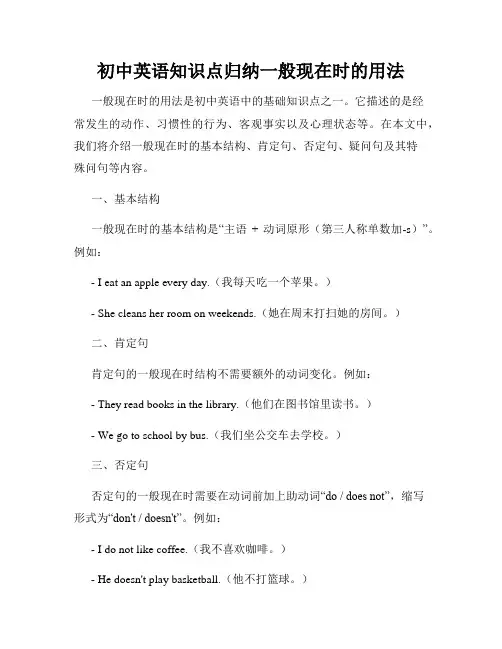
初中英语知识点归纳一般现在时的用法一般现在时的用法是初中英语中的基础知识点之一。
它描述的是经常发生的动作、习惯性的行为、客观事实以及心理状态等。
在本文中,我们将介绍一般现在时的基本结构、肯定句、否定句、疑问句及其特殊问句等内容。
一、基本结构一般现在时的基本结构是“主语+ 动词原形(第三人称单数加-s)”。
例如:- I eat an apple every day.(我每天吃一个苹果。
)- She cleans her room on weekends.(她在周末打扫她的房间。
)二、肯定句肯定句的一般现在时结构不需要额外的动词变化。
例如:- They read books in the library.(他们在图书馆里读书。
)- We go to school by bus.(我们坐公交车去学校。
)三、否定句否定句的一般现在时需要在动词前加上助动词“do / does not”,缩写形式为“don't / doesn't”。
例如:- I do not like coffee.(我不喜欢咖啡。
)- He doesn't play basketball.(他不打篮球。
)四、疑问句疑问句的一般现在时需要将助动词“do / does”置于句首,并将主语与动词的位置互换。
例如:- Do you have a pen?(你有一支钢笔吗?)- Does she watch TV every evening?(她每天晚上看电视吗?)五、特殊疑问句特殊疑问句的一般现在时需要以特殊疑问词(如what, where, when, why, how等)开头,并按照疑问句的结构进行构建。
例如:- What do you do in your free time?(你在空闲时间都做些什么?)- How often does he go swimming?(他多久去游泳一次?)六、陈述句、否定句和疑问句的转换为了让学生更好地理解一般现在时的用法,可以通过转换不同的句子形式来练习。
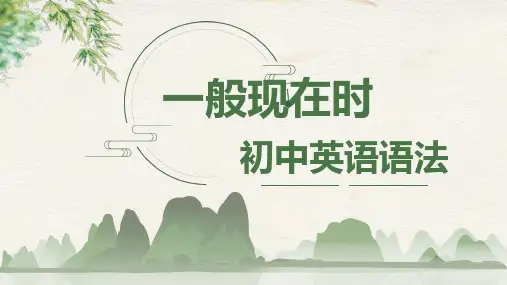
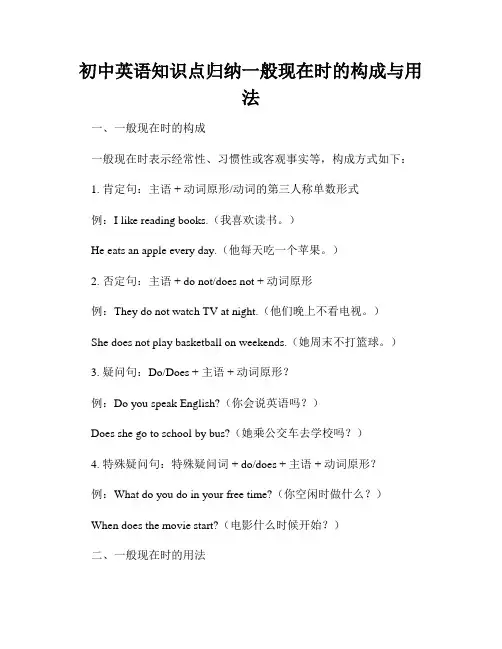
初中英语知识点归纳一般现在时的构成与用法一、一般现在时的构成一般现在时表示经常性、习惯性或客观事实等,构成方式如下:1. 肯定句:主语 + 动词原形/动词的第三人称单数形式例:I like reading books.(我喜欢读书。
)He eats an apple every day.(他每天吃一个苹果。
)2. 否定句:主语 + do not/does not + 动词原形例:They do not watch TV at night.(他们晚上不看电视。
)She does not play basketball on weekends.(她周末不打篮球。
)3. 疑问句:Do/Does + 主语 + 动词原形?例:Do you speak English?(你会说英语吗?)Does she go to school by bus?(她乘公交车去学校吗?)4. 特殊疑问句:特殊疑问词 + do/does + 主语 + 动词原形?例:What do you do in your free time?(你空闲时做什么?)When does the movie start?(电影什么时候开始?)二、一般现在时的用法一般现在时用于以下几种情况:1. 表示经常性或习惯性的动作或状态。
例:My mother often cooks dinner for us.(我妈妈经常给我们做晚饭。
)We usually go to the park on weekends.(我们通常在周末去公园。
)2. 表示客观事实、自然规律或科学真理。
例:The sun rises in the east.(太阳从东方升起。
)Water boils at 100 degrees Celsius.(水在100摄氏度沸腾。
)3. 表示现有状况或个人特征。
例:I have two cats.(我有两只猫。
)She lives in London.(她住在伦敦。
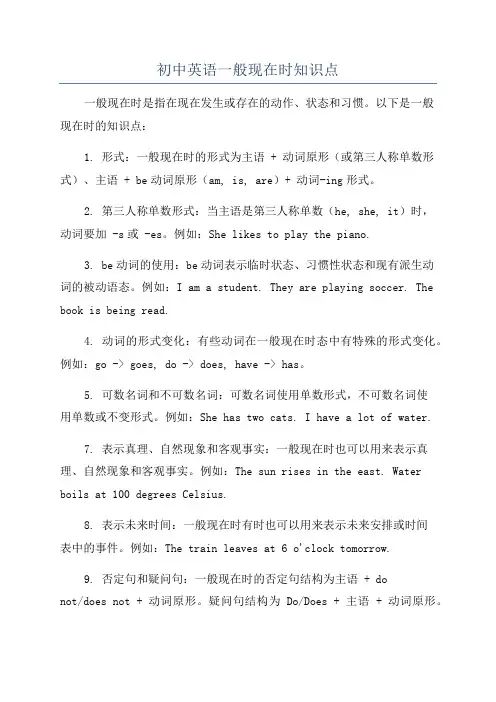
初中英语一般现在时知识点一般现在时是指在现在发生或存在的动作、状态和习惯。
以下是一般现在时的知识点:1. 形式:一般现在时的形式为主语 + 动词原形(或第三人称单数形式)、主语 + be动词原形(am, is, are)+ 动词-ing形式。
2. 第三人称单数形式:当主语是第三人称单数(he, she, it)时,动词要加 -s或 -es。
例如:She likes to play the piano.3. be动词的使用:be动词表示临时状态、习惯性状态和现有派生动词的被动语态。
例如:I am a student. They are playing soccer. The book is being read.4. 动词的形式变化:有些动词在一般现在时态中有特殊的形式变化。
例如:go -> goes, do -> does, have -> has。
5. 可数名词和不可数名词:可数名词使用单数形式,不可数名词使用单数或不变形式。
例如:She has two cats. I have a lot of water.7. 表示真理、自然现象和客观事实:一般现在时也可以用来表示真理、自然现象和客观事实。
例如:The sun rises in the east. Water boils at 100 degrees Celsius.8. 表示未来时间:一般现在时有时也可以用来表示未来安排或时间表中的事件。
例如:The train leaves at 6 o'clock tomorrow.9. 否定句和疑问句:一般现在时的否定句结构为主语 + donot/does not + 动词原形。
疑问句结构为Do/Does + 主语 + 动词原形。
以上是一般现在时的主要知识点,通过学习和掌握这些知识点,你就能正确运用一般现在时来描述现在的动作、状态和习惯。
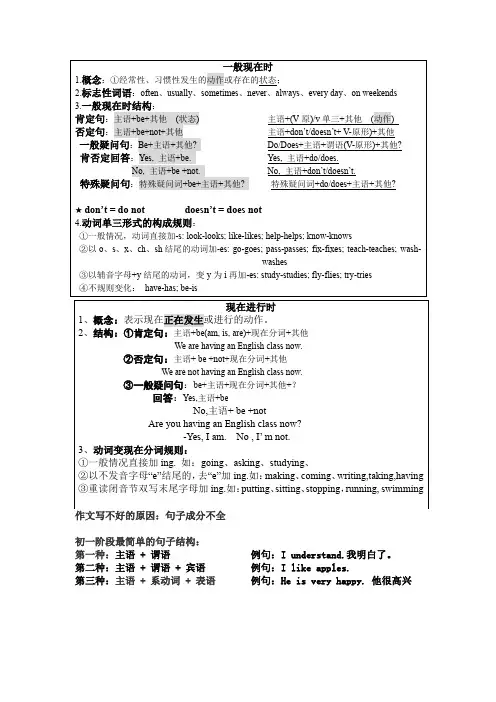
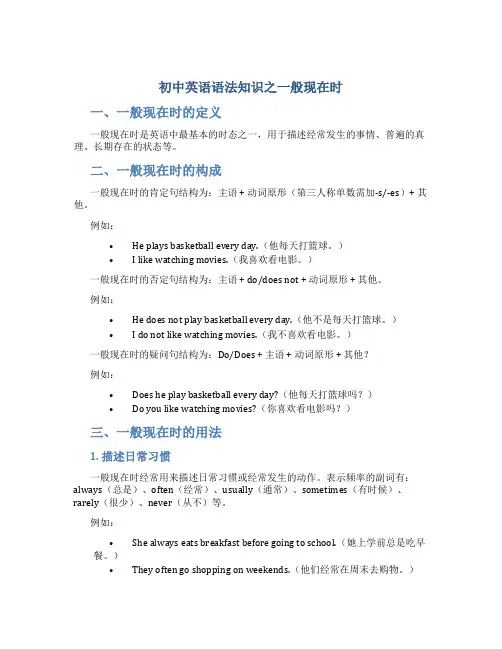
初中英语语法知识之一般现在时一、一般现在时的定义一般现在时是英语中最基本的时态之一,用于描述经常发生的事情、普遍的真理、长期存在的状态等。
二、一般现在时的构成一般现在时的肯定句结构为:主语 + 动词原形(第三人称单数需加-s/-es)+ 其他。
例如:•He plays basketball every day.(他每天打篮球。
)•I like watching movies.(我喜欢看电影。
)一般现在时的否定句结构为:主语 + do/does not + 动词原形 + 其他。
例如:•He does not play basketball every day.(他不是每天打篮球。
)•I do not like watching movies.(我不喜欢看电影。
)一般现在时的疑问句结构为:Do/Does + 主语 + 动词原形 + 其他?例如:•Does he play basketball every day?(他每天打篮球吗?)•Do you like watching movies?(你喜欢看电影吗?)三、一般现在时的用法1. 描述日常习惯一般现在时经常用来描述日常习惯或经常发生的动作。
表示频率的副词有:always(总是)、often(经常)、usually(通常)、sometimes(有时候)、rarely(很少)、never(从不)等。
例如:•She always eats breakfast before going to school.(她上学前总是吃早餐。
)•They often go shopping on weekends.(他们经常在周末去购物。
)2. 表达客观事实或普遍真理一般现在时也被用来表达客观事实或普遍真理。
例如:•The Earth revolves around the sun.(地球绕太阳运行。
)•Water boils at 100 degrees Celsius.(水在100摄氏度沸腾。

初中英语语法八大时态一.一般现在时1.结构肯定句式:主语+动词原形/动词的第三人称单数+其他否定句式:主语+(助动词)don't/doesn't+动词原形+其他一般疑问句式:Do/Does+主语+动词原形+其他简略回答:(肯)Yes,主语+do/does(否)No,主语+do/does not缩写形式:don't=do not doesn't=does not例句:He often goes swimming in summer.I usually leave home for school at7every morning.2.用法1)表示经常的、习惯性的动作或存在的状态,常与表示频度的副词连用。
常用的频度副词有:always、often、usually、seldom、never、sometimes,every week(day,year, month…),once a week,on Sundays.频度副词在句中通常放在行为动词之前,系动词、助动词之后。
例如:He often goes swimming in summer.I usually leave home for school at7every morning.2)表示主语具备的性格、特征和能力等。
例如:All my family love football.My sister is always ready to help others.Ann writes good English but does not speak well.3)表示客观真理、客观存在、自然现象。
例如:The earth moves around the sun.Shanghai lies in the east of China.4)表示按计划或安排好的,或将要发生的动作,可用一般现在时表将来。
但只限于start,begin,leave,go,come,arrive,return,take place等。
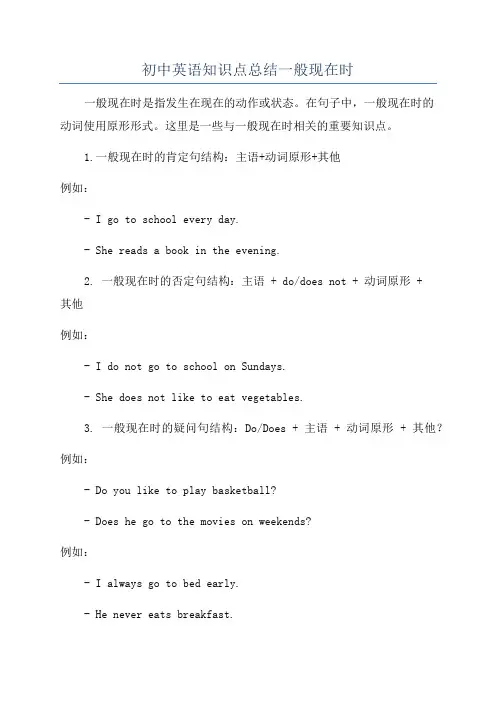
初中英语知识点总结一般现在时一般现在时是指发生在现在的动作或状态。
在句子中,一般现在时的动词使用原形形式。
这里是一些与一般现在时相关的重要知识点。
1.一般现在时的肯定句结构:主语+动词原形+其他例如:- I go to school every day.- She reads a book in the evening.2. 一般现在时的否定句结构:主语 + do/does not + 动词原形 +其他例如:- I do not go to school on Sundays.- She does not like to eat vegetables.3. 一般现在时的疑问句结构:Do/Does + 主语 + 动词原形 + 其他?例如:- Do you like to play basketball?- Does he go to the movies on weekends?例如:- I always go to bed early.- He never eats breakfast.5. 表示客观真理、规律或常识时,一般现在时可用于所有人称,不需要使用助动词do/does。
例如:- The sun rises in the east.- Water boils at 100 degrees Celsius.6. 当主语为第三人称单数时,动词需要变化。
一般情况下,加上-s 或-es。
例如:- She eats lunch at 12 o'clock.- The dog barks loudly.7.部分动词在第三人称单数时需要做变化- go→goes- do→does- have→has例如:- He goes to school by bus.- She does her homework every day.- My mother has a pet cat.8. 当主语为we, they, you或复数名词时,动词不需要做变化。
初中英语语法知识之一般现在时有很多同学分不清时态,时态是一篇文章的主线,如果时态都分不清那我们就分不清事情发生的先后,会对我们做题设障碍,所以今天小编为大家整理了一些时态上的知识,希望能帮到大家。
一般现在时表示现在经常反复发生的动作、存在的状态或习惯性的动作的时态。
一、一般现在时用法如下:1.表示现在的状态: e.g. He’s twelve. She’s at work.2.表经常或习惯性的动作,常与表示频度的时间状语连用。
: eg. I get up at 6:30 every day.He reads English every morning.3.表主语具备的性格、能力和特征。
e.g. I don't like this book.4.表示客观事实和普遍真理。
The earth moves around the sun.5. 在时间状语从句和条件状语从句中,常用一般现在时代替将来时。
eg. I'll write to you as soon as I arrive there.二、一般现在时构成:一般现在时用行为动词的原形,但第三人称单数作主语时,动词要用第三人称单数形式。
第三人称单数形式的变化规则是:1.一般的动词词尾+S。
2.以sh/ch/s/x 结尾的词+es.3.以辅音字母+Y 结尾的把 Y 变成 i,+es。
4.辅音字母+o 结尾的+es.基本结构:1.be 动词肯定句:主语+be(am,is,are)+其它。
如: I am a boy.我是一个男孩。
否定句:主语+ be + not +其它。
如:He is not a worker.他不是工人。
一般疑问句:Be +主语+其它。
如:-Are you a student? -Yes. I am. / No, I'm not.特殊疑问句:疑问词+一般疑问句。
如:Where is my bike?2.行为动词1) 当主语为第一,二人称及复数时,助动词为 do肯定句:主语+动词原形(+其它)。
一般现在时与一般过去时的区别初中语法重点解析一般现在时和一般过去时是英语语法中两种最基本的时态。
它们在使用上有所不同,主要表达现在和过去的动作或状态。
本文将对这两种时态的区别进行初中语法重点解析。
一、一般现在时一般现在时用于描述经常性、习惯性或普遍性的动作或状态。
1. 基本句式结构:主语 + 动词的原形(一般动词加-s或-es)2. 表达经常性习惯的词语:常常(often)、通常(usually)、有时候(sometimes)、总是(always)等。
3. 示例:- I often go to the park on weekends.(我经常在周末去公园。
)- She usually reads books before bedtime.(她通常在睡前看书。
)二、一般过去时一般过去时用于描述过去发生的动作或状态。
1. 基本句式结构:主语 + 动词的过去式形式2. 表达过去的时间段词语:昨天(yesterday)、上个月(last month)、去年(last year)等。
3. 示例:- We visited our grandparents last weekend.(上个周末我们去看望了祖父母。
)- It rained heavily yesterday.(昨天下了一场大雨。
)三、一般现在时与一般过去时的区别1. 时间参照点:一般现在时是以现在为参照点,即描述现在或经常性的动作或状态;而一般过去时以过去某个具体时间为参照点,描述过去已经发生的动作或状态。
2. 动词形式变化:一般现在时中,动词一般保持原形,但第三人称单数要加上-s或-es。
而一般过去时中,动词需变为过去式形式。
3. 时间状语的使用:一般现在时通常结合时间状语词或者副词来表示经常性的动作或状态;而一般过去时则结合过去的时间段词语。
4. 示例比较:- 现在:- I often play basketball in the park.(我经常在公园打篮球。
七年级英语重点语法:一般现在时1.一般现在时的用法①表示经常性、习惯性的动作或存在的状态。
常与频度副词连用。
I often take a walk in the park. 我经常在公园散步。
These T-shirts are new. 这些T恤衫是新的。
①表示客观事实、真理。
The sun rises in the east and sets in the west. 太阳东升西落。
①在时间、条件状语从句中表示将来的动作。
If it doesn’t rain tomorrow, I will go bike riding in the open air. 如果明天不下雨,我将在户外骑自行车。
I’ll tell her the good news when she comes back. 当她回来的时候,我将把这个好消息告诉她。
①表示按计划或安排将要发生的动作,可用一般现在时表将来。
但只限于start,begin,leave,go,come,arrive,return,take place等。
2.一般现在时的构成语法知识精练题型一:“三单”形式的变化规则1.—What happens when water freezes?—It ________ into ice.A.turns B.will turn C.turned D.has turned2.Tom ________ to school by bike every morning.A.go B.went C.is going D.goes3.The boy never ________ his teeth before bedtime. His parents are very angry.A.brush B.brushes C.brushed D.brushing4.The earth is a planet (行星) and it ________ around the sun.A.goes B.go C.will go D.went5.Mr. Green has two dogs. He ____________ them every morning.A.walked B.will walk C.walks D.is walking6.Amy usually ________ sports on Sunday mornings.A.is having B.has C.has had D.was having7.Tony usually ________ to school on time, but this morning he ________ late.A.gets; arrives B.got; arrived C.gets; arrived D.got; arrives8.She usually ________ to music in the evening, but now she ________ TV.A.listens; watches B.is listening; watchesC.listens; is watching D.is listening; is watching9.Mike usually _______ up at six thirty in the morning, but he _______ up at seven this morning. He was late for school.A.got; got B.got; gets C.gets; gets D.gets; got10.Linda _________ a twin brother, and she is _________ than him.A.is; taller B.has; tall C.has; taller D.have; taller11.It often _________ here in winter. Look! It’s _________ again.A.snows; snowing B.snowy; snowingC.snows; snows D.snowing; snows12._______ his sister, he also ________ running.A.Like; like B.Likes; likes C.Like; likes D.Likes; like13.Tommy always ________ to keep healthy. Look! He ________ in the pool now.A.swims; swims B.swims; is swimmingC.is swimming; is swimming D.is swimming; swims14.Bob ________ basketball and he looks ________ his father.A.likes, like B.like, likes C.likes, likes D.like, like15.—Does Ella like ________?—Yes. She often ________ things from the stores.A.shop; buys B.shop; is buyingC.shopping; buys D.shopping; is buying16.It often _________ heavily in summer. We have to wear raincoats when we go out.A.rains B.rain C.snows D.snow17.It often ______ in South China.A.snow B.snows C.rainy D.rains18.Jane sometimes ________ around the city with her parents on weekends.A.travel B.travelsC.traveled D.will travel19.When ice melts, it ________ into water.A.turns B.will turn C.turned D.is turning20.Mike ________ of medium height and he ________ short hair.A.is, is B.are, have C.has, has D.is, has题型二:表示经常性动作/状态21.I ______ basketball on the playground with my friends every Saturday.A.play B.will play C.played D.am playing22.Every year, the Vienna New Year’s Concert ________ place on 1st January.A.takes B.is taking C.took D.will take23.Tom usually ______ his bike to school but he ______ the subway there this morning.A.rides; took B.rides; takes C.ride; took D.rode; took24.Chinese people often ________ when they meet visitors.A.smile B.smiled C.are smiling D.will smile25.—Steve, what do you often do after school?—I often ________ basketball with my friends.A.play B.played C.will play D.am playing26.Susan lives far from school. She usually ________ a bus to school.A.has taken B.took C.takes D.will take27.—Listen! Someone ________ in the next room.—It must be Lily. She ________ singing every afternoon.A.sings; practices B.sings; practicing C.is singing; practices D.is singing; is practicing 28.—It ________ heavily last night. So there is snow on the ground everywhere today.—Yes. It often ________ here in winter.A.snowed; snows B.snowed; is snowing C.snows; is snowing D.snows; snows 29.Jim often ________ for a walk after dinner. But yesterday he ________.A.go; doesn’t B.goes; didn’t C.went; didn’t D.went; doesn’t 30.He often _________ French after _________ his homework every day.A.study; finish B.studied; finished C.studies; finishing D.studying; finishing题型三:表示现在的能力/特征31.—Does Alice like oranges?—No, she doesn’t. She ________ apples.A.like B.liking C.liked D.likes32.The store _______ T-shirts in all colors and they’re on _______.A.sell; sale B.sale; sell C.sells; sale D.sales; sell33.My brother _______ the piano very well, but he doesn’t have time to play now.A.will play B.is playing C.played D.plays34.Many years ago, I ________ to be a doctor. But now ________ a worker.A.wanted; I was B.wanted; I’mC.want; I’m D.want; I was35.My sister ________ walk a year ago, but now she ________.A.couldn’t; could B.couldn’t; can C.can; can D.could; could题型四:表示事实或客观真理36.—Where ________ he from?—He is from the United States.A.was B.are C.am D.is37.Allen used _________ to school, but now he _________ to school by bus.A.walking; goes B.walking; is going C.to walk; goes D.to walk; going 38.One of my friends ________ a pet dog. The dog’s name is Duoduo.A.have B.has C.to have D.having39.— We ________ very simply and do not spend much money on food.— That’s why you’re called the Greens.A.eat B.ate C.will eat D.had eaten40.— Look at the sign there! It ________ “No fishing!”— Sorry, I __________ notice it.A.said; don’t B.said; didn’t C.says; didn’t D.says; don’t 41.—Let’s buy some ________ for our school trip.—That ________ good.A.strawberry; sound B.salad; sounds C.hamburger; sounds D.pear; sound42.I ________ a red book. She ________ two red books.A.have; has B.has; have C.have; have D.has; has43.As we all know, light ________ a lot faster than sound.A.travels B.travelled C.is travelling D.to travel44.One of his best friends ________ the US.A.come from B.is from C.are from D.are coming from 45.His mother ________ in a hospital, but she ________ there these days.A.works; isn’t workingB.is working; worksC.is work; doesn’t workD.works; not works题型五:表示现在发生的具体动作46.—What club does he join?—He can _________ pictures, so he ________ the art club.A.draw; join B.draws; joins C.draws; join D.draw; joins 47.—Great news! The land (着陆) of The Shenzhou XIII is a great success!—It ________ me excited and ________ proud to be a Chinese.A.make; feel B.made; to feel C.makes; feel D.makes; feeling 48.I at the picture now. I some koalas in it.A.am looking; see B.look; seeingC.am looking; am seeing D.look; see49.—The phone is ringing, Sam.— I _______, but I’m busy. Could you answer it, please?A.know B.knowing C.am knowing D.knew 50.Mike _________ the earphones on the sofa a moment ago, but now they _________ there. A.put; weren’t B.put; aren’tC.putted; are D.puts; are参考答案:1.A【详解】句意:——当水冻结时会发生什么?——它会变成冰。
初中英语语法一般现在时全解一、什么是一般现在时?一般现在时是英语中最基本、最常用的时态之一,用于表示现在的状态、习惯、规律以及客观真理等。
在一般现在时中,动词的变化很简单,除了第三人称单数形式的动词要加上-s或者-es之外,其他人称动词均保持原型形式。
二、句型结构在一般现在时中,句子结构使用“主语+谓语动词”的形式。
下面是一些根据句型结构的例子:1. I play basketball every weekend.(我每个周末打篮球。
)2. She loves dancing.(她喜欢跳舞。
)3. They watch TV every night.(他们每晚看电视。
)4. We go to school from Monday to Friday.(我们从周一到周五去上学。
)三、使用情况1. 表示现在的真实状态:I live in Beijing.(我住在北京。
)2. 表示经常发生的动作:I usually go to the gym in the morning.(早上我通常去健身房。
)3. 表示普遍真理或客观规律:The sun rises in the east.(太阳从东方升起。
)4. 表示评论、陈述、想法等:I think English is an interesting subject.(我认为英语是个有趣的科目。
)四、一般现在时的注意事项1. 第三人称单数形式的动词要加上-s或者-es:He reads books every day.(他每天阅读书籍。
)但是要注意规则动词的变化,如do变为does。
2. 否定句需要在谓语动词前加上助动词do或does,并在其后加上not:I do not like coffee.(我不喜欢咖啡。
)She does not listen to music.(她不听音乐。
)3. 疑问句需要将助动词do或does提前至主语之前:Do you play tennis?(你打网球吗?)Does she go to school by bus?(她坐公交车去上学吗?)4. 当主语为第三人称单数时,疑问句直接用助动词does,无需加s:Does he like ice cream?(他喜欢冰淇淋吗?)五、总结一般现在时是英语中最基础、最常用的时态之一,用于表示现在的状态、习惯、规律以及客观真理等。
初中英语“一般现在时”
一般现在时
标志:动词原形
1. 表示经常性或习惯性动作,常与表频度的时间状语连用:
She often speaks English.
I leave home for school at 7 every morning.
2. 表示现在的状态、特征、职业、能力、感觉等:
He seems to feel a bit down today.
He works as a driver.
3. 表示真理、客观存在、科学事实或用于格言警句中:
Shanghai lies in the east of China.
Columbus proved that the earth is round.
Where there is a will, there is a way.
4. 表示现在瞬间的动作:
Here comes the bus!
5. 表示将来1) 表按规定、计划、安排将要发生的动作(仅限于某些表示“来、去、动、停、开始、结束、继续”等的趋向动词),可以与表示未来的时间状语搭配使用。
常见的用法是:飞机、火车、轮船、汽车等定期定点运行的交通状况。
如:
The next train leaves at 3 o’clock this afternoon.
How often does the shuttle bus run?
2) 在时间和条件状语从句中常使用一般现在时表示将来发生的事情:
When Bill comes (不用will come), ask him to wait for me.
I shall go there tomorrow unless I’m too busy.。